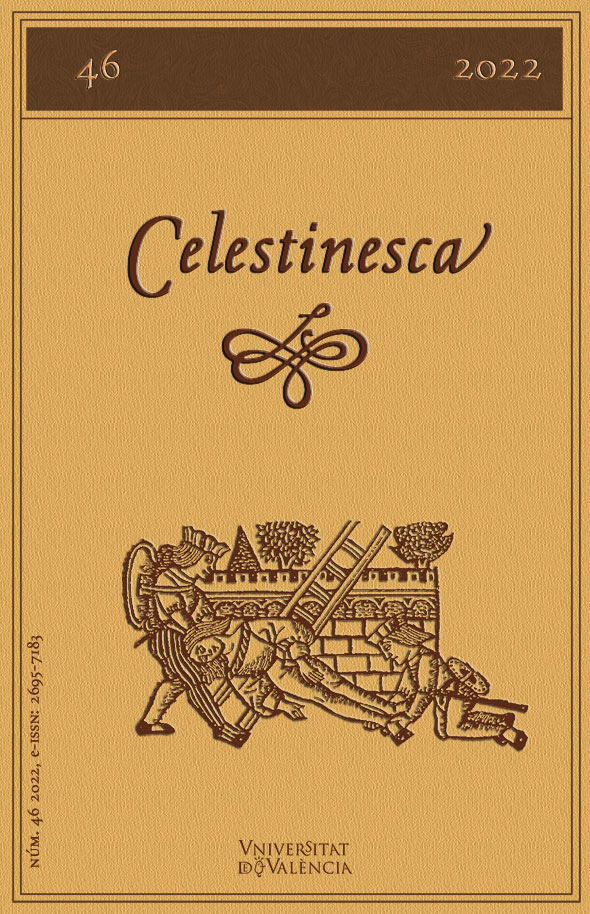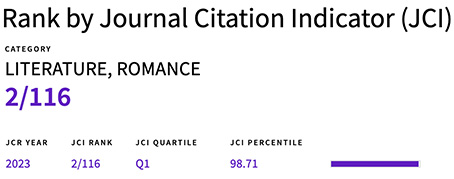Literary lessons by Sancho de Muñón in the Tragicomedia de Lisandro y Roselia
DOI:
https://doi.org/10.7203/Celestinesca.46.25406Keywords:
Celestina, Imitation, Dissents, Jurist speech, The keeper of honour Abstract
Abstract
In the Tragicomedia de Lisandro y Roselia, Oligides, Lisandro’ servant, argues against Celestina’s supposed resurrection when she reappeared in the Segunda Celestina and the Tercera parte. He shows that she was instead a different procuress. Elicia, who succeeds her aunt’s profession in the cuarta obra, denies being a matchmaker, as the procuress denies being one in the Tercera parte. Thus, Sancho de Muñón follows his predecessors’ general path in his Tragicomedia. However, he chooses different ways; for instance, he introduces legal language instead of using speeches of African slaves, or that of a rustic shepherd or an inhabitant from Biscay, like in the other two Celestinas. The writer does not keep the minor servants in his work, but instead, he gives a brother to Roselia, Beliseno who is the keeper of the family's honour. Beliseno is also the one who brings the tragic and terrible ending to the Tragicomedia, as he kills Lisandro and Roselia in the garden with his arrows.
 Downloads
Downloads
 References
References
Castro Guisasola, Florentino (1924), Observaciones sobre las fuentes literarias de «La Celestina», Madrid, Anejo 5 de la RFE.
Gómez, Gaspar (2016), Tercera parte de la tragicomedia de Celestina, en Segundas Celestinas, ed. de Rosa Navarro Durán, Madrid, Biblioteca Castro.
Heugas, Pierre (1973), «La Célestine» et sa descendance directe, Bordeaux, Éditions Bière.
La comedia Thebaida (1968), ed. G. D. Trotter y Keith Whinnom, London, Tamesis Books.
― (2003), ed. José Luis Canet Vallés, Salamanca, Ediciones Universidad de Salamanca.
Lida, María Rosa (1962), La originalidad artística de «La Celestina», Buenos Aires, Editorial Universitaria.
Menéndez Pelayo, Marcelino (1943), Orígenes de la novela, IV, ed. Enrique Sánchez Reyes, Santander, Aldus – CSIC.
Muñón, Sancho de (2009), Tragicomedia de Lisandro y Roselia, ed. Rosa Navarro Durán, Madrid, Cátedra.
― (2016), Tragicomedia de Lisandro y Roselia, ed. Rosa Navarro Durán, Madrid, Biblioteca Castro.
― (2015), «¿Murió o no murió Celestina? El texto literario como desmentido», en Porque eres, a la par, uno y diverso. Estudios literarios y teatrales en homenaje al profesor Antonio Sánchez Trigueros, Antonio Chicharro (ed.), Granada, Universidad de Granada, pp. 563-580.
― (2018a), «Caminos abiertos en una comedia transgresora: La Segunda Celestina de Feliciano de Silva», en Celestinesca, nº 42, pp. 375-394. https://doi.org/10.7203/Celestinesca.42.20231
― (2018b), «La Lozana Andaluza», un retrato en clave. Pasquines históricos en la Roma Babilonia, Sevilla, Renacimiento.
― (2020), «Siguiendo el guion, pero guardando el decoro: cuchilladas y libreas en la Tercera Celestina», en Celestinesca, nº 44, pp. 405-430. https://doi.org/10.7203/Celestinesca.44.19442
Ovidio Nasón, Publio (1969), Metamorfosis, II, trad. de Antonio Ruiz de Elvira, Barcelona, Alma Mater.
Piccolomini, Eneas Silvio (2001), Estoria muy verdadera de dos amantes, Euríalo franco y Lucrecia senesa, ed. Inés Ravasini, en Tratados de amor en el entorno de «Celestina» (siglos XV-XVI), coord. Pedro M. Cátedra, Madrid, Sociedad Estatal España Nuevo Milenio, pp. 161-217.
Quevedo, Francisco de (2005), La vida del Buscón, en Novela picaresca, II, ed. Rosa Navarro Durán, Madrid, Biblioteca Castro.
Rojas, Fernando de, y «antiguo autor» (2000), La Celestina, ed. Francisco Rico et al., Barcelona, Crítica.
Silva, Feliciano de (1988), Segunda Celestina, ed. Consolación Baranda, Madrid, Cátedra.
― (2016), Segunda comedia de Celestina, en Segundas Celestinas, ed. Rosa Navarro Durán, Madrid, Biblioteca Castro.
Torres Naharro, Bartolomé de (1994), Obra completa, ed. Miguel Ángel Pérez Priego, Madrid, Biblioteca Castro.
Vian Herrero, Ana (1997), «Transformaciones del pensamiento mágico: el conjuto amatorio en La Celestina y en su linaje literario», en Cinco siglos de Celestina: Aportaciones interpretativas, Rafael Beltrán y José Luis Canet (ed.), València, Universitat de València, pp. 209-238.
― (2010), «Sancho de Muñón y las innovaciones literarias en el ciclo celestinesco: a propósito de una nueva edición de la Cuarta Celestina», Boletín de la Biblioteca de Menéndez Pelayo, LXXXVI, pp. 455-470. https://www.cervantesvirtual.com/nd/ark:/59851/bmc0976072 (fecha última consulta: 01/12/2022)
Whinnom, Keith (1988), «El género celestinesco: origen y desarrollo», en V Academia literaria renacentista. Literatura en la época del Emperador, Víctor García de la Concha (dir.), Salamanca, Universidad de Salamanca, pp. 119-130.
Downloads
Published
How to Cite
-
Abstract360
-
PDF (Español)340
Issue
Section
License
![]() Celestinesca is committed to the dissemination of knowledge, that is why access to its contents is free and is ruled by a Creative Commons Attribution-NonCommercial-NoDerivatives 4.0 license.
Celestinesca is committed to the dissemination of knowledge, that is why access to its contents is free and is ruled by a Creative Commons Attribution-NonCommercial-NoDerivatives 4.0 license.
Authors retain the rights to their works. Therefore, they can disseminate them and deposit them in the repository, institutional or not, that they wish. However, they are kindly requested to do so by providing the full bibliographic reference and the corresponding DOI.
Celestinesca does not charge authors for submitting, processing, reviewing or publishing their articles.





